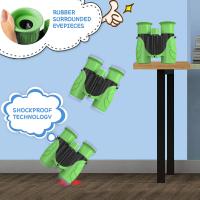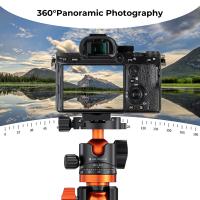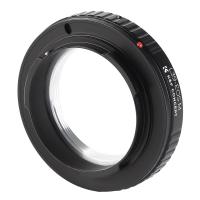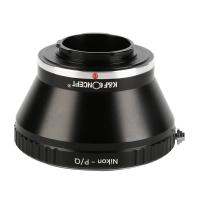Can Atoms Be Seen Through A Microscope ?
Atoms cannot be directly seen through a traditional light microscope due to their extremely small size. The resolution of a light microscope is limited by the wavelength of visible light, which is much larger than the size of an atom. However, there are advanced techniques such as scanning tunneling microscopy (STM) and atomic force microscopy (AFM) that can visualize atoms. These techniques involve scanning a sharp probe over the surface of a sample and measuring the interactions between the probe and the atoms. By mapping these interactions, it is possible to create images that reveal the positions of individual atoms. STM and AFM have revolutionized our understanding of atomic structures and have been instrumental in various fields of science and nanotechnology.
1、 Atomic Force Microscopy: Visualizing atoms using a probe.
Yes, atoms can be seen through a microscope, specifically through a technique called Atomic Force Microscopy (AFM). AFM is a powerful tool that allows scientists to visualize and manipulate individual atoms and molecules with remarkable precision.
Unlike traditional optical microscopes, which use light to magnify and visualize objects, AFM works by using a tiny probe to scan the surface of a sample. The probe, typically a sharp tip attached to a cantilever, interacts with the atoms on the surface, and the resulting forces are measured and used to create an image.
AFM has revolutionized our understanding of the nanoscale world. It has provided valuable insights into the structure and behavior of atoms, molecules, and surfaces. By mapping the topography of a sample at the atomic level, AFM can reveal the arrangement and positions of individual atoms.
In recent years, AFM has advanced even further, allowing scientists to not only see atoms but also manipulate them. With the development of techniques like atomic manipulation and atomic resolution imaging, researchers can now move individual atoms and molecules, creating new structures and studying their properties.
It is important to note that while AFM can visualize atoms, it does not provide direct visual images like traditional optical microscopes. Instead, it generates a representation of the atomic surface based on the forces detected by the probe. Nonetheless, AFM has become an indispensable tool in nanoscience and nanotechnology, enabling scientists to explore and manipulate the building blocks of matter at the atomic scale.

2、 Scanning Tunneling Microscopy: Imaging atoms through electron tunneling.
Yes, atoms can be seen through a microscope, specifically through a technique called Scanning Tunneling Microscopy (STM). STM is a powerful tool that allows scientists to image individual atoms and manipulate them at the atomic level.
In STM, a sharp metal tip is brought very close to the surface of a sample, typically a conductive material. A small voltage is applied between the tip and the sample, creating a tunneling current. By measuring this current, scientists can map the surface topography of the sample with atomic resolution.
The principle behind STM is based on the quantum mechanical phenomenon of electron tunneling. When the tip is brought close enough to the sample, electrons can "tunnel" through the small gap between them. The tunneling current is highly sensitive to the distance between the tip and the sample, allowing for precise measurements of atomic positions.
STM has revolutionized our understanding of the atomic world. It has provided direct visual evidence of atoms and molecules, revealing their arrangement and behavior on surfaces. This technique has been instrumental in various fields of research, including materials science, nanotechnology, and surface chemistry.
It is important to note that STM can only be used to image conductive materials, as the tunneling current relies on the flow of electrons. However, advancements in microscopy techniques have expanded the possibilities of imaging non-conductive materials as well. For instance, Atomic Force Microscopy (AFM) can be used to image non-conductive samples by measuring the forces between the tip and the surface.
In conclusion, Scanning Tunneling Microscopy allows us to see atoms through electron tunneling. This technique has revolutionized our understanding of the atomic world and continues to be a valuable tool in various scientific disciplines.

3、 Transmission Electron Microscopy: Directly observing atoms using electron beams.
Transmission Electron Microscopy (TEM) is a powerful technique that allows for the direct observation of atoms using electron beams. Unlike traditional light microscopes, which are limited by the wavelength of visible light, TEM uses a beam of electrons to illuminate the sample, providing much higher resolution and the ability to see individual atoms.
In TEM, a thin sample is placed in the path of the electron beam, and the electrons interact with the atoms in the sample. These interactions produce a variety of signals, including transmitted electrons, scattered electrons, and emitted electrons. By detecting and analyzing these signals, scientists can obtain detailed information about the structure and composition of the sample at the atomic level.
The resolution of TEM has improved significantly over the years, allowing for the direct visualization of individual atoms. In fact, recent advancements in TEM technology, such as aberration correction and high-angle annular dark-field imaging, have pushed the resolution to the sub-angstrom level. This means that atoms can now be seen and distinguished from one another in many materials.
However, it is important to note that not all atoms can be seen equally well with TEM. The visibility of atoms depends on factors such as the atomic number, crystal structure, and thickness of the sample. Lighter elements, such as hydrogen and helium, are more challenging to observe due to their low scattering power. Additionally, the sample must be thin enough to allow electrons to pass through without significant scattering or absorption.
In conclusion, while not all atoms can be seen equally well, Transmission Electron Microscopy has made significant advancements in directly observing atoms using electron beams. With the latest technologies, scientists can now visualize and study individual atoms in various materials, providing valuable insights into the atomic-scale structure and properties of matter.

4、 Scanning Electron Microscopy: High-resolution imaging of atomic surfaces.
Yes, atoms can be seen through a microscope, specifically through a Scanning Electron Microscope (SEM). SEM is a powerful tool that allows for high-resolution imaging of atomic surfaces. It uses a beam of electrons to scan the surface of a sample, and the interaction between the electrons and the atoms produces signals that can be detected and used to create an image.
In SEM, the electron beam scans the sample in a raster pattern, and as the electrons interact with the atoms on the surface, various signals are generated. These signals include secondary electrons, backscattered electrons, and characteristic X-rays. By detecting and analyzing these signals, SEM can provide detailed information about the topography, composition, and even crystal structure of the sample.
The resolution of SEM is typically in the range of a few nanometers, allowing for the visualization of individual atoms or atomic arrangements on a surface. However, it is important to note that SEM does not directly "see" atoms like an optical microscope sees larger objects. Instead, it detects the signals produced by the interaction of electrons with atoms.
It is worth mentioning that recent advancements in SEM technology, such as aberration correction and improved detectors, have further enhanced the resolution and capabilities of SEM. These advancements have enabled researchers to study atomic structures and phenomena with unprecedented detail, opening up new possibilities in materials science, nanotechnology, and various other fields.
In conclusion, while atoms cannot be directly seen like macroscopic objects, Scanning Electron Microscopy provides a means to visualize atomic surfaces and study their properties at high resolution.





























